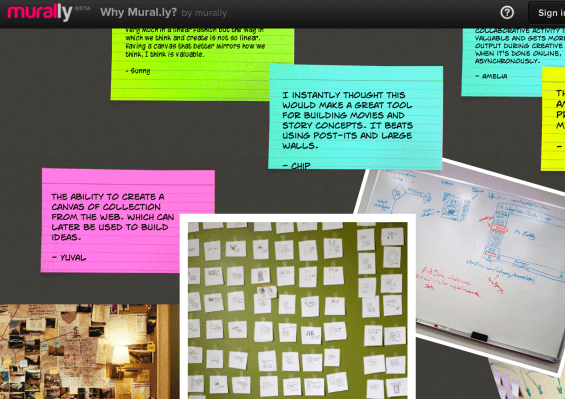Buenos Aires-based startup Mural.ly opened its doors to the public today, delivering a new way to collect, share and brainstorm on the web. The tool mixes a little bit of Evernote with a whole lot of Prezi, but rather than feel derivative, it instead seems like the next natural step in the ongoing evolution of how we not only think about, but share and collaborate on ideas together online. Mural.ly is also announcing a seed round of $775,000 alongside its public launch, provided by Intel Capital, Alta Ventures, 500 Startups and a number of other investors.
What Mural.ly offers is a new way to collect and share ideas that gets away from the traditional, page-based way of looking at things. That means that, like with Prezi, users get a scrollable space which can grow both horizontally and vertically according to needs, instead of being limited by traditional paper dimensions that have been standard for years, first with physical notebooks and then with the earliest digital tools that replaced them. Users can grab websites, photos, audio and other media and work arrange them on a virtual canvas, as well as invite others to work together at the same time in the same space, something Mural.ly founder Mariano Suarez Battan thinks is generative of unique, creative results. Finally, Mural.ly is also designed to be at home on touch devices, so the web product is ready and optimized for touch input and manipulation via devices like the iPad.
Creativity is something Battan is very familiar with, having previously founded startup gaming company Three Melons, later acquired by Playdom, which itself went on to be acquired by Disney as part of its interactive department. Mural.ly had its roots in game design, and is built on a creative workflow that encourages the kind of thinking needed to make a game truly original and engaging, but Battan says it quickly became apparent there were potential applications for Mural.ly that went well beyond its original purpose.
“I used translated spatial memory and spatial features of my brain into software,” Battan explained about the genesis of the product, as he worked with his engineering team to build Mural.ly. “Generally software is built around tablets and grids and lists, but sometimes for the creative process that’s not so useful.”
Asked why Mural.ly is different enough from tools like Prezi to not feel like a clone, Battan points to its focus on integrating content from around the web, including maps, Pinterest content, Dropbox files, Wikipedia entries and more. Maybe more importantly, he says that unlike with Prezi, narrative is a secondary concern. It’s true that when I’ve spoken with Prezi founder Peter Arvai in the past, discussion of non-presentation uses of Prezi has been discussed as a welcome secondary development, while Battan characterizes Mural.ly as a free-form brainstorming tool first, to which users can later apply a narrative should they so choose. Finally, Mural.ly is based heavily around group collaboration, and is definitely meant for teams.
One thing Battan should definitely appreciate about bearing a resemblance to Prezi is that company’s skyrocketing engagement, which recently saw it top 12 million users worldwide. If Mural.ly can build a similar following, by perhaps appealing more to creative agencies and design professionals first, it could be on a path to similar success.
